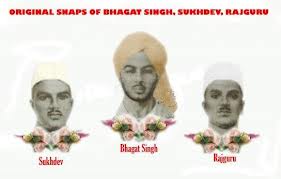“Some make their parents proud but only few make their nation”
23rd March. It is not a mere date. It is an historic day that crowns the sacrifice of Martyrs- Shaheed Bhagat Singh, Shivaram Rajguru, and Sukhudev Thapar.
These revolutionaries sacrificed their lives for the freedom of India. They infused a sense of patriotism and determination among people to drive out Britishers from the soil of India.
People from masses praised their courage and love they had for their motherland. They faced gallows and an extremely hard life behind the bars.
Among Martyrs, who willingly walked on the path of thorn, the name of Bhagat singh, Rajguru and Sukdev shines like stars.
~~
Bhagat Singh truly stated “You can kill Individual but not ideas. Great empires crumbled but ideas survive”.
He became immortal at the age of 23.
Someone has rightly stated “your age does not define your maturity but your action does”.
Bhagat singh was born in quaint revolutionary Sikh family on 28th September 1907. He was so true to his name as “Bhagat” means “Devotee” and he was devoted to the cause of his mnotherland and her freedom.
Bhagat singh was influenced by his grandfather, Arjun Singh, who was an ardent follower of Swami Dayananda Saraswati’s Hindu reformist movement, Arya Samaj. Unlike other Sikh Children, He refused to let his grandson attend the Khalsa High School in Lahore. He instead enrolled Bhagat in the Dayanand Anglo Vedic High School, an Arya Samaji Institution.
He was an Atheist:
Though he belonged to a Sikh family, very few people know that he belonged to no religion. He was an atheist. Singh began to question religious ideologies after witnessing the Hindu–Muslim riots that broke out after Gandhi disbanded the Non co-operatiopn Movement. He did not understand how members of these two groups, initially united in fighting against the British, could be at each other’s throats because of their religious differences. At that very point, Singh dropped his religious beliefs and began reading works of Bruknin, Lenin, Trotsky-all atheist revolutionaries.
He even scoffed the idea of getting married saying that anybody could get married but, him? He would free India.
Barbaric Act
Then the fateful day arrived, the barbaric act, killing of hundreds gathered for a peaceful meeting at the Jallianwala Bagh. The incident disturbed a 12 year-old Bhagat enough to make him skip school the day after and visit the Bagh. There he collected mud soaked in blood of innocent men, women children, in a bottle and took the bottle home. He worshiped that bottle of mud every day after that.
Turning Point:
The tragic death of Lala Lajpat Rai was another turning point in Bhagat Singh’s life.
In 1928, the British Government set up a Simon Commission to report on the political situation in India. The Indian political parties boycotted the Commission, because it did not include a single Indian in its membership, which led to country-wide protests.
Lala Lajpat Rai who was leading a non-violent protest against the Simon Commission when the Commission visited Lahore on 30 October 1928, got grievously injured when the police under orders from James A. Scott, lathi charged on the unsuspecting crowd.
Lalaji died on 17 November 1928.
Singh vowed to take revenge for Lalaji’s murder and joined other revolutionaries, Shivaram Rajguru, Sukhdev Thapar and Chandrashekhar Azad, in a plot to kill Scott.
However, in a case of mistaken identity Bhagat Singh and Rajguru shot Assistant Superintendent of Police John P. Saunders on 17 December 1928. Although Bhagat Singh and Rajguru managed to escape after killing Saunders. It is then that Sukhdev, Bhagat Singh’s best friend, called on Durgawati Devi’s assistance. Bhagat Singh dressed in western attire and carrying Devi’s sleeping child passed off as Durga Devi’s husband while Rajguru carried their luggage and pretended to be their servant. They then took the train to Cawnpore.
Bomb Explosion and Arrest:
Bhagat Singh came up with the idea of throwing two explosive bomb inside the Central Legislative Assembly to protest the Defence of India Act 1915 on 8 April 1929. It was then the police connected Bhagat Singh to the murder of Saunders with the help of the HSRA members turned informants.
Singh was sent to the Mianwali jail from the Delhi jail. During his time in the jail he witnessed the glaring discrimination between European and Indian prisoners. He demanded that all prisoners be treated equally. He coined the term “political prisoner” and led other prisoners in a hunger strike to protest against this discrimination. The Government tried everything to break the strike, from placing water pitchers filled with milk, so that the prisoners will be forced to drink when thirsty and not water, to force feeding through a tube. But none of the government’s tricks would suffice to break the revolutionaries’ morale.
This strike led to death of a prisoner Jatindra Nath Das who died on 13 September 1929 after a 63-day hunger strike. Bhagat Singh finally ended his, never heard of before, 116-day hunger strike on 5 October 1929.
Gloomy Day
Then came the grim day of 7 October 1930 when Bhagat Singh and his friends, Sukhdev and Rajguru were sentenced to death for the murder of John P. Saunders.
The way the death sentence of the three brave crusaders of freedom was carried out is still a controversy. Bhagat Singh, Sukhdev and Rajguru were hanged to death 11 hours prior to the original time their sentenced was to be carried out.
Their hanging was scheduled on 24 March 1931 but they were hanged on 23 March 1931 at 7:30 pm in Lahore jail. The jail authorities then broke the rear wall of the jail and secretly cremated the three martyrs under cover of darkness outside Ganda Singh Wala village, and then threw their ashes into the Sutlej River.
Memorial
The place where Singh was cremated, at Hussainiwala on the banks of the Sutlej River, became Pakistani territory during the partition.
On 17 January 1961, it was transferred to India in exchange for 12 villages near the Sulemanki Headworks. During the 1971 India–Pakistan war, the memorial was damaged and the statues of the martyrs were removed and taken away by the Pakistani army. They have not been returned but the memorial was rebuilt in 1973.
The Shaheedi Mela (Punjabi: Martyrdom Fair) is an event held annually on 23 March and sees people paying homage at the National Martyrs Memorial. The day is also observed across the Indian state of Punjab.
Even after fighting with fortitude and sacrificing his life at the young age of 23 for the freedom of this country, Bhagat Singh is still not represented as a martyr in government records. Responding to an inquiry under Right to Information Act the Home Ministry said that it possesses no record to prove that Bhagat Singh has been declared a martyr. There might be no record to prove him a martyr but that doesn’t take away from his greatness and try as we may we can never really forget the cries of: “Inquilab Zindabad!“. He is known As “Prince of Martyrs”.





